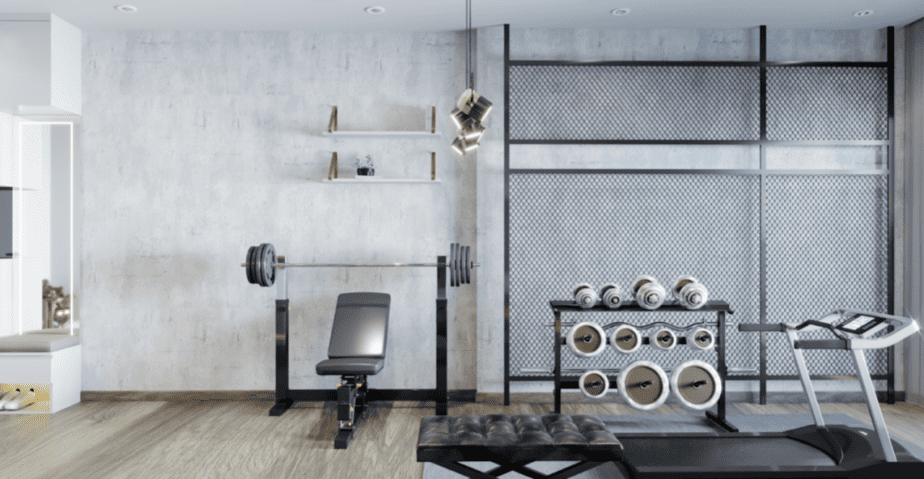
Ergonomic design in gym spaces focuses on creating environments that complement the human body’s natural movements, enhancing comfort and reducing the risk of injury.
Proper ergonomics can significantly improve the effectiveness of your workout by aligning equipment and space to your body’s needs.
- Adjustability: Equipment should be adjustable to fit different body sizes and shapes.
- Accessibility: Layouts must allow for easy access to equipment and unobstructed movement.
- Comfort: Seating and touchpoints should support the body comfortably during exercise.
When designing a home gym, it’s crucial to consider the flow of movement between different workout stations. An ergonomic gym layout not only facilitates a seamless transition from one exercise to the next but also ensures that each area is tailored to the exercises performed there, allowing for a safe and efficient workout experience.
Assessing Your Space for Ergonomic Design
When assessing your space for ergonomic gym design, it’s crucial to consider the dimensions and shape of the room. Measure the length, width, and height to ensure adequate space for equipment and movement. Take note of any obstructions like pillars or low ceilings that could limit the functionality of your gym.
- Identify the room’s dimensions
- Note potential obstructions
- Consider natural light and ventilation
Ergonomics is not just about the equipment but also about the environment. A well-lit and ventilated space can significantly enhance your workout experience.
Additionally, think about the flow of your workout routine. You’ll want to position the equipment in a way that allows for a natural transition between exercises. This planning helps in reducing the risk of injury and increases the efficiency of your workout sessions.
Choosing the Right Space for Your Home Gym
Space Considerations for Different Types of Workouts
When selecting the right space for your home gym, it’s crucial to consider the type of workouts you plan to engage in. Cardio enthusiasts will need ample room for treadmills or stationary bikes, while those focusing on strength training might prioritize space for free weights and benches. Yoga or Pilates practitioners, on the other hand, require a serene area that can accommodate mats and possibly wall space for inversions.
- Cardio Workouts: Space for machines, good airflow, and sound insulation.
- Strength Training: Room for weights, benches, and possibly squat racks.
- Yoga/Pilates: Quiet area with enough floor space for mats and movement.
Remember, the functionality of your gym space should evolve with your fitness journey. It’s not just about fitting equipment into a room; it’s about creating an environment that adapts to your changing workout needs and goals.
Lastly, consider the potential for multi-functional equipment that can save space. Adjustable dumbbells, foldable workout benches, and door-mounted pull-up bars are excellent examples of how to maximize the utility of your home gym while keeping space requirements to a minimum. If you’re looking to add an extra touch of relaxation to your home gym, consider choosing a massage chair!
Maximizing Small Spaces
Designing a home gym in a small space can be challenging, but with the right approach, it’s possible to create an efficient and inviting workout area. Prioritize equipment that offers multiple functions to save space without sacrificing the quality of your workout. For instance, adjustable dumbbells can replace an entire rack of weights and a foldable workout bench can be easily stored away when not in use.
- Use vertical space: Install shelves or wall mounts for storing equipment off the floor.
- Opt for collapsible items: Choose items like yoga mats and resistance bands that can be tucked away easily.
- Mirror placement: Position mirrors to create the illusion of a larger space and for form-checking during exercises.
By carefully selecting equipment and utilizing clever storage solutions, even the smallest of spaces can become a productive area for exercise. Remember, the goal is to create a space that feels open and uncluttered, promoting a clear mindset for your fitness journey.
Essential Workout Equipment for an Ergonomic Home Gym
Selecting Equipment with Mobility in Mind
When designing an ergonomic home gym, selecting the right equipment is crucial. Equipment with mobility in mind allows for a versatile workout experience and can be easily reconfigured to suit various exercises and space constraints.
- Adjustable dumbbells: Save space and allow for a range of weight options.
- Resistance bands: Offer a variety of resistance levels and are easy to store.
- Foldable workout bench: Can be tucked away when not in use.
- Wall-mounted pull-up bars: Utilize vertical space and are retractable.
Ensuring that your equipment can be moved or stored with ease will not only keep your home gym organized but also provide the flexibility to adapt your workout area as your fitness routine evolves.
Remember, the goal is to create a space that can accommodate a dynamic range of activities without the clutter of traditional, bulky gym equipment. By prioritizing mobility, you’ll be able to maintain an open and adaptable workout environment.
Restore Mobility enhances this vision by offering a selection of mobility products designed to support an active and flexible lifestyle in any space. Their innovative mobility aids and tools are tailored to improve your physical wellness while seamlessly integrating into your home, ensuring you can achieve a full range of motion and strength without sacrificing space or the aesthetic of your environment.
Innovative Storage Solutions for Gym Equipment
When designing a home gym, innovative storage solutions are key to maintaining an organized and efficient workout space. Proper storage not only keeps your gym tidy but also extends the life of your equipment by protecting it from damage.
- Wall-mounted racks: Ideal for storing weights and bars off the floor, maximizing space.
- Ceiling storage: Utilize overhead space for items like resistance bands and jump ropes.
- Collapsible and stackable designs: Equipment that folds or stacks can drastically reduce the footprint when not in use.
- Multi-purpose furniture: Consider benches with built-in storage or modular shelving that can adapt to your changing needs.
By integrating smart storage solutions, you can transform even the smallest of spaces into a fully functional home gym. This approach not only streamlines your workout area but also encourages a clutter-free environment that is conducive to focus and motivation.
Designing Your Space for Motivation and Efficiency
Incorporating Ergonomic Flooring
Choosing the right flooring for your home gym is crucial for both comfort and safety. Ergonomic flooring can significantly reduce fatigue and the risk of injury during workouts. It provides the necessary cushioning and support for high-impact activities and can also help to dampen noise.
- Rubber tiles or mats are a popular choice for their durability and shock absorption.
- Foam tiles offer a softer surface, ideal for yoga or Pilates.
- Vinyl or laminate can be suitable for areas with heavy equipment, offering ease of cleaning and maintenance.
When selecting flooring, consider the type of workouts you’ll be doing and the level of impact they involve. High-density flooring options are better for weightlifting zones, while softer, more cushioned materials suit aerobic activities or stretching areas.
Remember to measure your space accurately and consider the ease of installation. Some flooring options come in interlocking pieces, making them simple to fit and adjust as needed. Maintenance is also a key factor; opt for materials that are easy to clean and can withstand regular use.
Enhancing Your Workout with Technology
In the digital age, technology has become a pivotal aspect of home gym design, offering innovative ways to track progress, stay motivated, and enhance the overall workout experience. Smart fitness equipment has revolutionized the way we exercise, with machines like treadmills and stationary bikes now featuring integrated screens that provide real-time feedback and virtual training sessions.
- Wearable Technology: Track your heart rate, calories burned, and sleep patterns.
- Fitness Apps: Access personalized workout plans and instructional videos.
- Virtual Reality (VR): Immerse yourself in virtual environments for an engaging cardio session.
Embracing technology in your home gym not only adds an element of fun but also enables precise monitoring of your fitness journey. Allowing for more targeted and effective workouts.
Moreover, smart home assistants can be used to control the gym’s environment, such as lighting and temperature, or to play motivational music, all through voice commands. This seamless integration of technology ensures that your home gym is not just a place to exercise, but a dynamic fitness hub tailored to your personal goals and preferences.
Maintenance and Safety in Your Home Gym
Keeping Your Gym Clean and Safe
Maintaining a clean and safe environment in your home gym is crucial for ensuring a healthy workout space. Regular cleaning not only prevents the spread of germs but also extends the life of your equipment. Develop a routine that includes wiping down machines after each use and scheduling deep cleans.
- Start by disinfecting high-touch surfaces such as handles, knobs, and screens.
- Use a gentle cleaner on mats and flooring to avoid deterioration.
- Inspect equipment regularly for wear and tear, and repair or replace items as necessary.
Remember, a well-maintained gym is a cornerstone of your fitness journey. It’s not just about aesthetics; it’s about creating a space where you can focus on your health.Without distractions or hazards.
By adhering to a consistent cleaning schedule, you ensure that your home gym remains a safe and inviting space for your daily workouts. This discipline in maintenance also reflects the dedication you have towards your personal fitness goals.
Conclusion
In conclusion, designing a home gym that is both ergonomic and motivating requires careful consideration of space, equipment, and maintenance. By understanding the principles of ergonomic design, choosing the right space for your workouts, selecting the appropriate equipment, and incorporating motivational elements, you can create a fitness zone that enhances your workout experience. Remember to prioritize safety and cleanliness to ensure a safe and enjoyable environment for your fitness routine.
Frequently Asked Questions
What are the key principles of ergonomic design in gym spaces?
The key principles of ergonomic design in gym spaces focus on creating a layout that promotes natural movements, reduces strain on the body, and enhances user comfort and safety.
How can I assess my space to ensure ergonomic design for my home gym?
You can assess your space by considering factors such as room dimensions, natural lighting, ventilation, and the placement of equipment to optimize functionality and comfort.
What are some space considerations for different types of workouts in a home gym?
Space considerations for different types of workouts include allocating sufficient room for cardio equipment, strength training areas, stretching zones, and ensuring adequate clearance for movement.
How can I maximize a small space to create an ergonomic home gym?
You can maximize a small space by utilizing multi-functional equipment, vertical storage solutions, and strategic placement of mirrors to create the illusion of a larger area.
What factors should I consider when selecting workout equipment with mobility in mind?
When selecting workout equipment with mobility in mind, consider features such as adjustable settings, compact design, and ease of movement to accommodate different exercises and users.
What innovative storage solutions can I use to organize gym equipment in a home gym setting?
Innovative storage solutions for gym equipment include wall-mounted racks, foldable shelves, and modular storage units that optimize space and keep the area clutter-free.


















Follow Us